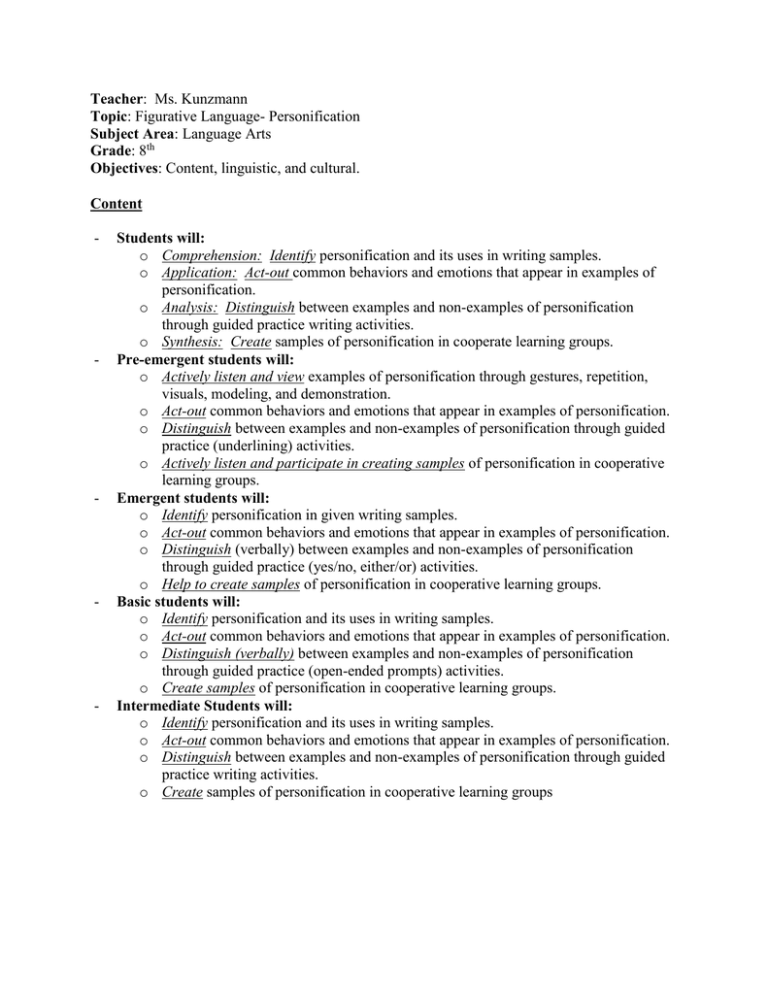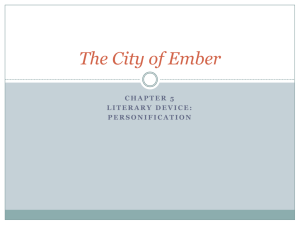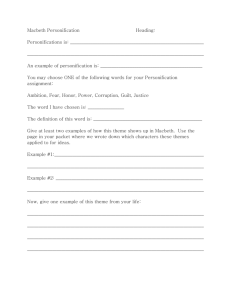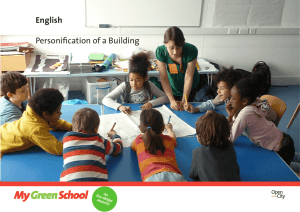- ESL101.com
advertisement

Teacher: Ms. Kunzmann Topic: Figurative Language- Personification Subject Area: Language Arts Grade: 8th Objectives: Content, linguistic, and cultural. Content - - - - - Students will: o Comprehension: Identify personification and its uses in writing samples. o Application: Act-out common behaviors and emotions that appear in examples of personification. o Analysis: Distinguish between examples and non-examples of personification through guided practice writing activities. o Synthesis: Create samples of personification in cooperate learning groups. Pre-emergent students will: o Actively listen and view examples of personification through gestures, repetition, visuals, modeling, and demonstration. o Act-out common behaviors and emotions that appear in examples of personification. o Distinguish between examples and non-examples of personification through guided practice (underlining) activities. o Actively listen and participate in creating samples of personification in cooperative learning groups. Emergent students will: o Identify personification in given writing samples. o Act-out common behaviors and emotions that appear in examples of personification. o Distinguish (verbally) between examples and non-examples of personification through guided practice (yes/no, either/or) activities. o Help to create samples of personification in cooperative learning groups. Basic students will: o Identify personification and its uses in writing samples. o Act-out common behaviors and emotions that appear in examples of personification. o Distinguish (verbally) between examples and non-examples of personification through guided practice (open-ended prompts) activities. o Create samples of personification in cooperative learning groups. Intermediate Students will: o Identify personification and its uses in writing samples. o Act-out common behaviors and emotions that appear in examples of personification. o Distinguish between examples and non-examples of personification through guided practice writing activities. o Create samples of personification in cooperative learning groups Linguistic - - - - - - Pre-emergent students will: o Understand new grade and content appropriate vocabulary. o Understand basic concepts about personification and respond to verbal/non-verbal cues, and yes/no questions. o Be exposed to language that focuses on conveying meanings and vocabulary development. o If possible, directions on hand-outs will be in student’s native language. Emergent students will: o Understand appropriate grade and content level vocabulary. o Understand the basic concepts about personification and respond through yes/no questions, either/or questions, and one/two-word responses. (Correct responses will be modeled in context.) o If possible, directions on hand-outs will be in student’s native language. Basic students will: o Understand appropriate grade and content level vocabulary. o Understand the basic concepts about personification and respond using simple sentences. o Respond to compare/contrast questions as well as open-ended questions that stimulate further language production. o If possible, directions on hand-outs will be in student’s native language. Intermediate students will: o Understand appropriate grade and content level vocabulary. o Understand the basic concepts about personification and demonstrate near-native or native like fluency. o Participate in reading and writing activities that foster further development. Cultural o This lesson does not require any background cultural knowledge. o Students will learn a concept from a lesson relative to figurative language. o Future activities could incorporate culture by exploring the use of figurative language in works of different parts of the world. Arizona State Standards: o 8.SL.1 (Speaking/Listening): Engage collectively in a range of collaborative discussions (on-on-one, in groups, and teacher led) with diverse partners on grade 8 topics, texts, and issues, building on others’ ideas and expressing their own clearly. o 8.SL.6 (Speaking/Listening): Adapt speech to a variety of contexts and tasks, demonstrating command of formal English when indicated and appropriate o 8.RL.4 (Reading Literature): Determine the meaning of words and phrases as they are used in a text, including connotative and figurative meanings, and analyze how specific word choice shape meaning and tone. o 8.L.5 (Language): Demonstrate understanding of figurative language, word relationships, and nuances in word meanings. - Materials: o Markers o Butcher paper o Overhead projector Personification in pictures transparency Personification in music transparency o Personification in poetry handout Emily Dickenson Mother Goose (See modified) o Group Personification worksheet o CD player o “I’m a believer” by Smash Mouth o Comic strip paper (for illustrations of poems) o Colored pencils Instructional Procedures Initiating activities/motivation: 1. Using large pieces of butcher paper or poster board and markers, write the word “People” large in the center. * Have students gather their desks or sit on the floor in front of you with the ELLs in the front. 2. Explain to the class, “We are going to make a word web of things that people do.” 3. Provide a couple of main ideas related to the topic as category headings. (Make it a point to suggest vocabulary that will come up later in worksheets.) Examples: Laugh and walk. 4. Encourage students to add suggestions, ask them about emotions and things that humans can do. Have students think of as many related words as they can (prior knowledge) and list them by categories on the paper. * After the semantic map has been developed, ask students (as a class) to act-out the words on the word-web. All ELL students will benefit from this. Non-verbal communication will put both the English and non-English speakers at equal advantage. In a low-risk situation, students who are unfamiliar with the new vocabulary will be able to emulate their peers. Copying others is learning, not cheating in this case. They will be able to learn the vocabulary by observing each other and the teacher. 5. Create another word-web concerning things that are not human. Examples for headings: animals, food, nature, and so on. Encourage students to add to the lists. (After the semantic maps are developed, share the list orally with students. Ask students to repeat the words after you. This will provide a good model for the ELL students and provide further repetition.) 6. Introduce the concept of personification: “When human characteristics or behaviors are given to non-human things; personification can be used in pictures, music, and poetry.” *Hang the word-webs on the wall or in a place where students can refer to them while they do further activities. Lesson Development Personification in pictures and music: 1. Using an overhead projector and transparencies, display the above page 2. Discuss each of the images with students. Ask questions like, “Are any of these pictures of a human?” “What are the things in the pictures?” “What are the things doing in the pictures?” (When addressing each picture, pointing to the image and stating what it is together with students will re-enforce any vocabulary for PE, E, as well as B students.) 3. Present the following questions to students verbally. 4. Ask students to fill in the blanks verbally with a word based on the pictures. (Reading the statements out loud and making gestures when you reach the blanks will re-enforce vocabulary and give students cues as to what the answer may be.) 5. After sufficient time has been given for the picture activity, put up the song lyrics transparency. 6. Give a brief introduction to the songs and their artists. 7. Play “I’m a believer” by Smash Mouth. Ask students to pay close attention to the lyrics, reading them as the artist sings them. 8. Play only the verse shown above. Re-read the lyrics to the students. Pause at the underlined parts and ask students to put up one finger if they think it’s an example of personification, and two fingers if they don’t think it’s an example. (Using these nonverbal gestures allow for the teacher to get instant feedback as to whether ELL students are following along.) 9. Repeat the same activity with the second song. This time only read the lyrics to the students, it’s not necessary to play the actual song. Guided practice worksheets (individual) 1. Pass out “Personification in Poetry” worksheet with Emily Dickenson and Mother Goose. 2. Allow adequate time for students to complete their activities. (See modified worksheets below.) 3. Circulate the room and help to stimulate students by asking yes/no, open-ended questions about the handouts. ESOL Modifications for Handouts Individual guided practice worksheets- “Personification in Poetry” Personification in Poetry (For Intermediate students) Directions: Underline examples of personification in each poem. When you’re done, write your answers to the questions at the bottom of the page. After reading Emily Dickenson’s poem, what is your opinion of the clouds and the wind? Why do you feel this way? Personification in Poetry (For Basic Students) Directions: Underline examples of personification in each poem. How are these poems like the examples we saw earlier? (Same poems, except question is answered verbally to the teacher). Personification in Poetry (For Emergent Students) Are the underlined words examples of personification OR non-examples? (Directions on this page are given in native language for clarification.) Asked and answered verbally. These students’ handouts appear as follows: Personification in Poetry (For Pre-Emergent students): Directions - Underline examples of personification. Use the pictures and word bank to guide you. (Directions on this page are given in native language.) Has same images, w/ addition of a word bank.) - - Evaluation/Assessment: 1. Active participation in initiating activities. (Gestures, thumbs up/thumbs down.) 2. Successful and accurate completion of individual and group worksheets. Did they share ideas? Did they make the connection between human and non-human things? ESOL Modifications for evaluation/assessment (add as many steps as needed) Add a copy of modified rubric or checklist or test that will be used for ESOL students. Pre-Emergent & Emergent: (Performance Based) 1. Active listening and participation in initiating activities. 2. Successful completion of individual worksheet: (Correctly underlined examples using word bank and pictures.) Basic & Intermediate: (Performance Based) 1. Active listening and participation in initiating activities. 2. Successful completion of individual worksheet: (Accurate response to verbal and/or written prompts.)


